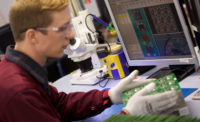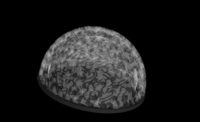What is Industry 4.0? This buzzword seems to have been thrown around for quite some time now. How is it affecting today’s NDT manufacturing processes compared to the past? What new technologies have risen from Industry 4.0 in the past few years to benefit NDT? To answer all these questions, it is important to look back and understand how it came to be.
The notion that machines could replace humans occurred during the first industrial revolution (1760-1840). This was the age of mechanical production, where the advent of the steam engine helped provide energy to advanced textile inventions like the spinning mule and power loom. Other industries like coal, iron and railroad industries boomed during this time as well. All of this symbolized the transition from human power in homes to machine power in factories.
The second industrial revolution, the age of science and mass production, began in 1870 and lasted until 1914 and witnessed the expansion of electricity, steel and petroleum. This paved the road to unprecedented urbanization and rapid territorial expansion. Railroads were invented which allowed for fast transportation of materials and thus allowing faster growth. This increased growth eventually led to the third industrial revolution.
The digital revolution, otherwise known as the third industrial revolution, was based on information technology and automation. Many important technologies emerged from this revolution, notably the internet, semiconductors and mainframe computing. These technologies gave rise to the production of miniaturized materials which would aid the expansion of space and biotechnology industries. Industry 3.0 began in 1969 and only recently has begun to shift into Industry 4.0 and what it is today: digitization and smart technology.

Photos courtesy of Fraunhofer Institute for Nondestructive Testing IZFP
Industry 4.0 (The Smart Revolution)
The fourth industrial revolution optimizes the computerization of Industry 3.0. Essentially, in the past five years, computers began to become connected and make decisions without human involvement. A combination of cyber-physical systems, the Internet of Things and the Internet of Systems make Industry 4.0 a reality.
Data is the center of the business due to digital information acquired from robots and software. This data, utilized correctly, can save companies millions of dollars by revealing trends and patterns that otherwise may have gone unnoticed.
Industry 4.0 operates on a few core principles: interoperability, information transparency, technical assistance and decentralized decisions. Machines must be able to communicate with each other, mainly through the Internet of Things (IoT). This should enable them to create virtual copies of the physical world via sensor data, assist humans by providing an aggregate visualization of information for better decision-making, and ensure that systems are capable of independently coming up with solutions and implementing the functions they were designed for.

Graphic Courtesy of Fraunhofer Institute for Nondestructive Testing IZFP
Ultimately, this new technology will make production faster, more efficient and highly flexible.
So how exactly is Industry 4.0 shaping the way NDT is done in factories? What benefit does it bring to companies and their customers?
How Industry 4.0 is affecting NDT in manufacturing
Industry 4.0 is helping companies using NDT by improving decision making in real time, providing predictive maintenance, and speeding up the production process by analyzing the mass amounts of data stored by robots. For companies, this allows them to save cost by reducing the time it takes to test parts and address any customer complaints much faster or remove them completely. Through Industry 4.0, companies can control every aspect of the manufacturing phase from the raw product to the final completed part and make changes that are efficient and cost effective.
As technology advances and changes, so do the wants and needs of the customer. No longer do customers want test systems in the conventional sense. They now want solutions that are smart, offer added value, and help them optimize their processes.
For example, in an article titled “The Future of NonDestructive Testing in the Context of Industry 4.0,” Professor Randolf Hanke gives an example of how he was tasked to find the most efficient and cost-effective way of extracting data on the internal dimensions of thousands of different shoes so that online shoppers can be sure of choosing the right size. Using precise, high-speed computed tomography data, he was able to add further value by combining highly accurate X-Ray data with intelligent software. The result? The shoe company was able to advise its customers not only the best size to choose, but which shoe would provide the optimum fit.

Acquired image (above ↑ ), enhanced image with ADR (below ↓ ).

I4.0 is also helping manufacturers obtain smart monitoring for their customers. As Hanke says, “In the future it won’t be just a case of deciding whether a part is good or bad. Rather, it will be about providing customers with a monitoring system that shows them how they can optimize their processes.”
Automated evaluation and decision making is one of the most essential aspects when talking about NDT 4.0.
Different technologies affecting NDT today
I4.0 is helping businesses all over the world by improving efficiency of production using smart technologies such as machine learning, robots and smart controllers, additive manufacturing (3D printing), cloud, and more.
3D printing has evolved tremendously in the last decade. Now, companies can print parts from an increasing range of materials like carbon fiber to metal. This capability allows for companies to save cost and quickly manufacture a replacement part.
The Internet of Things is characterized by the connectivity it allows and not only does it help internal operations, but through cloud computing, where data is stored, equipment and operations can be optimized.
Using machine learning, programs can analyze millions of data points and use automatic defect recognition software to not only locate defects on a part, but also recognize what kind of defect. This information is crucial as it can allow manufacturers to change their manufacturing process if need be, granting the flexibility that can save companies money in the long run.
Ultimately, new technologies like these have a huge impact on NDT today and continues to advance and grow as more companies are figuring out how to utilize it in the most efficient way possible.



